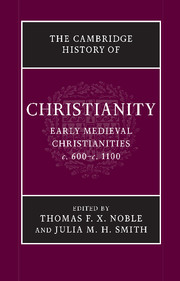Book contents
- Frontmatter
- Introduction: Christendom, c. 600
- Part I Foundations: Peoples, Places, and Traditions
- Part II Christianity in Confrontation
- Part III Christianity in the Social and Political Order
- Part IV Christianity as Lived Experience
- 18 Birth and death
- 19 Remedies for sins
- 20 Sickness and healing
- 21 Gender and the body
- 22 Sacrifice, gifts, and prayers in Latin Christianity
- 23 Performing the liturgy
- Part V Christianity: Books and Ideas
- Conclusion: Christendom, c. 1100
- Bibliographies
- Index
- References
19 - Remedies for sins
from Part IV - Christianity as Lived Experience
Published online by Cambridge University Press: 28 March 2010
- Frontmatter
- Introduction: Christendom, c. 600
- Part I Foundations: Peoples, Places, and Traditions
- Part II Christianity in Confrontation
- Part III Christianity in the Social and Political Order
- Part IV Christianity as Lived Experience
- 18 Birth and death
- 19 Remedies for sins
- 20 Sickness and healing
- 21 Gender and the body
- 22 Sacrifice, gifts, and prayers in Latin Christianity
- 23 Performing the liturgy
- Part V Christianity: Books and Ideas
- Conclusion: Christendom, c. 1100
- Bibliographies
- Index
- References
Summary
Man is a sinful creature. Even in paradise man sinned by disobeying the command of his Lord. After the Fall, man not only sinned in thoughts, words, and deeds, but was also affected by original sin. Christian grace was able to dispense with original sin through the ritual of baptism, but although the average Christian may have wanted desperately to abide by divine rules, in practice he never succeeded completely in doing so. Only a handful of saints were able to avoid every kind of sin. Therefore, one had to decide how to deal with sin. In the period we are dealing with here – the period from the sixth to the twelfth century – we can discern important developments in the way Christians tried to handle this question.
When the Irish abbot Cummian (fl. c. 632), in the seventh century, wrote a preface to his collection of penitential decisions, he listed twelve remedies for sins, or “remedies of wounds,” as he called them. He presented these with biblical citations bolstering their effectiveness. The list of remedies starts with baptism, and continues with the virtue of love (caritas), the fruit of alms, the shedding of tears, the confession of crimes, the affliction of the heart and body, the emendations of one’s ways, the intercession of saints, the merits of mercy and faith, the conversion and salvation of others, pardoning others for their sins, and finally, the passion of martyrdom. Cummian did not invent this list of remedies, but based it on an earlier work, the Collationes of John Cassian (c. 360–430), one of the founding fathers of western monasticism.
- Type
- Chapter
- Information
- The Cambridge History of Christianity , pp. 399 - 415Publisher: Cambridge University PressPrint publication year: 2008
References
- 1
- Cited by



